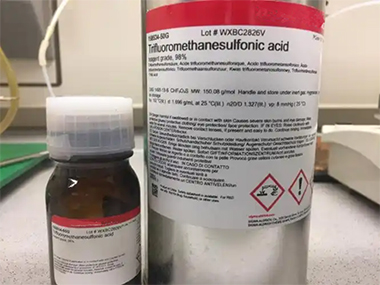Scientists and industries widely use trifluoromethanesulfonic acid (CF₃SO₃H) and sulfuric acid (H₂SO₄) in experiments and various applications. To compare the acidity of triflic acid and sulfuric acid, we start with the pKa of the two acids.
pKa is a measure of the acidity of a substance. It tells us how easily an acid donates a proton (H⁺).The lower the pKa value, the stronger the acid. This happens because stronger acids ionize more fully in solution.
Triflic acid: pKa ≈ -14.7
Sulfuric acid: pKa₁ ≈ -3
We can see that the pKa value of Triflic acid is greater than that of sulfuric acid. The reasons why it is more acidic we see from a professional point of view are two main points
1. Electron-Withdrawing Effect: The three fluorine atoms in triflic acid strongly pull electrons toward themselves. They pull electron density away from the sulfur atom, making the O-H bond weaker and easier to break. This results in a stronger tendency to donate a proton.
2.Stability of the Conjugate Base: When Triflic acid donates a proton, it forms the trifluoromethanesulfonate ion (CF₃SO₃⁻). This ion is stable because of the strong electronegative fluorines, which help to stabilize the negative charge. In contrast, the conjugate base of sulfuric acid (HSO₄⁻) is less stable.
Triflic acid is a powerful organic acid that has a wide range of applications in chemistry. Triflic acid is highly stable and works well in many acid-catalyzed reactions.
Catalyst in Organic Reactions: Chemists widely use it as a strong acid catalyst in various organic reactions.
Electrolyte in Battery: Researchers use it in some types of batteries, especially in experimental studies.
Synthesis of Pharmaceutical: It plays a role in the synthesis of various pharmaceutical compounds, enhancing reaction rates and yields.
Chemical Manufacturing: Used in the production of fluorinated compounds and other specialty chemicals.

Triflic acid (fluorosulfonic acid) is a strong acid, about several times more powerful than sulfuric acid, and is an important Brønsted acid. Its molecule contains three fluorine atoms, and these strongly electronegative fluorine atoms make it significantly more acidic, making it extremely acidic in the gas phase.
In organic chemistry, triflic acid is often used as an acid catalyst in the Friedel-Crafts reaction. As a Lewis acid, it can react with other acidic reagents (e.g. acylating agents) to form reactive alkyl or acyl cations, thus facilitating the alkylation and acylation of aromatic compounds. In addition, triflic anhydride, a derivative of triflic acid, is widely used in organic synthesis, especially as an efficient acylating agent in the synthesis of complex molecules.
Due to its extremely acidic nature and excellent catalytic properties, triflic acid plays a key role in many organic reactions, especially in reactions requiring strong acid catalysis, such as esterification and hydrogen bond formation. This makes triflic acid an important and indispensable reagent in modern organic chemistry research and industrial applications.
Contact: Tony Li
Phone: +86-13263299644
Tel: +86-13263299644
Email: sales@ecoviaet.com
Add: No 3 Youyi Road,Tangshan,Huantai,Zibo,China
We chat
